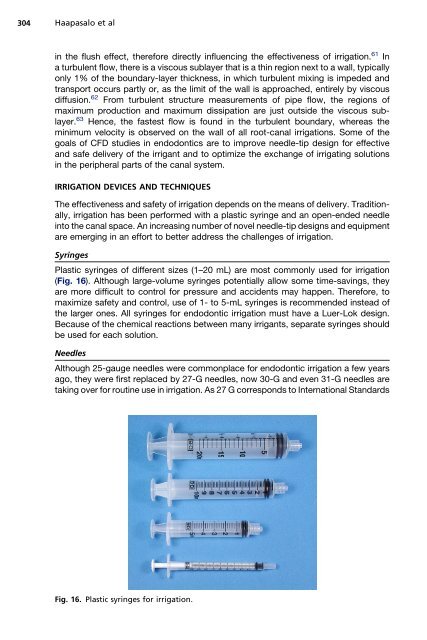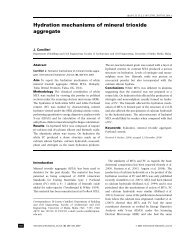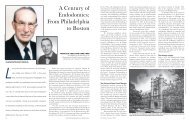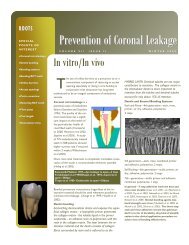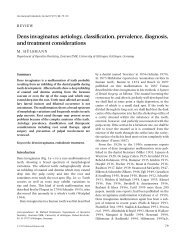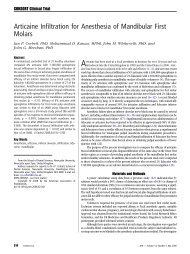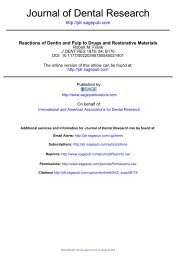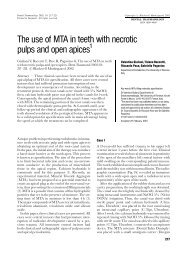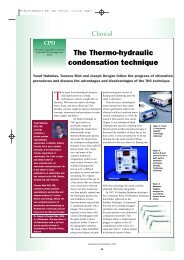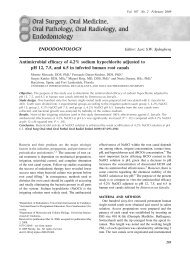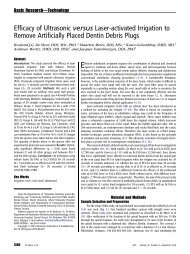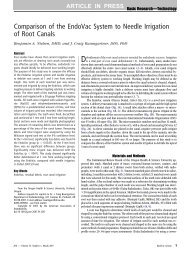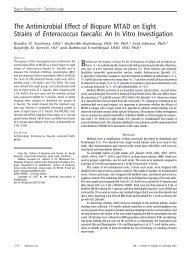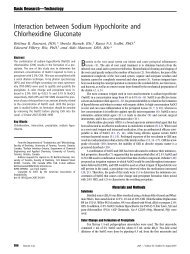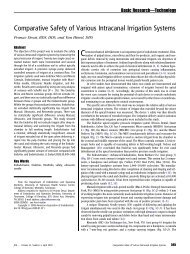Irrigation in Endodontics - The Endoexperience
Irrigation in Endodontics - The Endoexperience
Irrigation in Endodontics - The Endoexperience
Create successful ePaper yourself
Turn your PDF publications into a flip-book with our unique Google optimized e-Paper software.
304<br />
Haapasalo et al<br />
<strong>in</strong> the flush effect, therefore directly <strong>in</strong>fluenc<strong>in</strong>g the effectiveness of irrigation. 61 In<br />
a turbulent flow, there is a viscous sublayer that is a th<strong>in</strong> region next to a wall, typically<br />
only 1% of the boundary-layer thickness, <strong>in</strong> which turbulent mix<strong>in</strong>g is impeded and<br />
transport occurs partly or, as the limit of the wall is approached, entirely by viscous<br />
diffusion. 62 From turbulent structure measurements of pipe flow, the regions of<br />
maximum production and maximum dissipation are just outside the viscous sublayer.<br />
63 Hence, the fastest flow is found <strong>in</strong> the turbulent boundary, whereas the<br />
m<strong>in</strong>imum velocity is observed on the wall of all root-canal irrigations. Some of the<br />
goals of CFD studies <strong>in</strong> endodontics are to improve needle-tip design for effective<br />
and safe delivery of the irrigant and to optimize the exchange of irrigat<strong>in</strong>g solutions<br />
<strong>in</strong> the peripheral parts of the canal system.<br />
IRRIGATION DEVICES AND TECHNIQUES<br />
<strong>The</strong> effectiveness and safety of irrigation depends on the means of delivery. Traditionally,<br />
irrigation has been performed with a plastic syr<strong>in</strong>ge and an open-ended needle<br />
<strong>in</strong>to the canal space. An <strong>in</strong>creas<strong>in</strong>g number of novel needle-tip designs and equipment<br />
are emerg<strong>in</strong>g <strong>in</strong> an effort to better address the challenges of irrigation.<br />
Syr<strong>in</strong>ges<br />
Plastic syr<strong>in</strong>ges of different sizes (1–20 mL) are most commonly used for irrigation<br />
(Fig. 16). Although large-volume syr<strong>in</strong>ges potentially allow some time-sav<strong>in</strong>gs, they<br />
are more difficult to control for pressure and accidents may happen. <strong>The</strong>refore, to<br />
maximize safety and control, use of 1- to 5-mL syr<strong>in</strong>ges is recommended <strong>in</strong>stead of<br />
the larger ones. All syr<strong>in</strong>ges for endodontic irrigation must have a Luer-Lok design.<br />
Because of the chemical reactions between many irrigants, separate syr<strong>in</strong>ges should<br />
be used for each solution.<br />
Needles<br />
Although 25-gauge needles were commonplace for endodontic irrigation a few years<br />
ago, they were first replaced by 27-G needles, now 30-G and even 31-G needles are<br />
tak<strong>in</strong>g over for rout<strong>in</strong>e use <strong>in</strong> irrigation. As 27 G corresponds to International Standards<br />
Fig. 16. Plastic syr<strong>in</strong>ges for irrigation.


